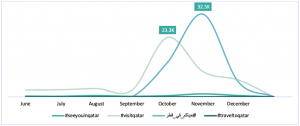Authored by: Moataz Fawzy
Without a doubt, Qatar 2022 is a World Cup of many firsts since the World Cup began in 1930. It is the first Arab or Islamic country to host the World Cup, the first to be held in winter, the first in which the host country has never actually played a world cup match and Qatar is geographically the smallest country to ever host a world cup. Even the official match ball, the Al Rihla, debuts as the first official match ball using water-based inks and glues to create the ball.
“The World Cup is meant to serve as an engine to push forward and accelerate a lot of the initiatives that the government has already committed to, already had planned, whether that’s in terms of urban development or economic diversification.”
Secretary General of the Supreme Committee for Delivery and Legacy, Hassan AlThawadi – Euronews
In the build-up to 2022, Qatar has spent billions of dollars since being chosen as a World Cup host in late 2010 – more than 15 times what Russia spent for the 2018 event – constructing some of the most eco-friendly and architecturally advanced sporting facilities, undertaking enormous economic and infrastructural developments, and revamping of its national infrastructure.
Qatar’s benefits will not be only economic but also in terms of country branding. Online for example, the number of mentions of the name “Qatar” outside the MENA region on Twitter increased from 2.8M in 2013 to more than 17M in 2022.

Figure 1: Number of mentions of #Qatar outside MENA Region (Arabic excluded), 2013 to 2022 (Network: Twitter)
“I’ve never seen a host being so ready so much in advance. All stadiums are finished. Infrastructure in terms of hotels and roads is being completed. So Qatar is ready. FIFA is ready, the world is ready. And after some complicated times with pandemics and others, we really need to come together again.”
FIFA President Gianni Infantino – Euronews
All these elements were estimated to make the World Cup experience in Qatar unique, and this is what Qatar promised and worked on, starting from booking a ticket for your team’s match until you leave the stadium.
In this article, we are going to walk you through the four stages of the fan journey; Tickets, Travel, Hotels, and Stadiums to provide you with insights into how Qatar is delivering its first and foremost experience.
◊ TICKETS (1/4)
Since Qatar was announced as the host of the 2022 World Cup, the ticket topic received approximately 600,000 mentions. The main topics revolved around the selling and reselling of tickets and the cost of the tickets themselves.
Qatar’s World Cup ticket prices are the highest in the last 20 years. This statement has received a lot of attention since the announcement of World Cup tickets. We have investigated this and according to FIFA, the average ticket price now is higher than Russia’s edition by 25%. The difference is minor in most of the tournament stages except for the final match which has increased by 46%. On the other hand, the average price of group stage tickets in its four categories was 7% lower than in Russia 2018.

Figure 2: Comparison between average 2018 & 2022 World Cup ticket prices (in USD) for all rounds. (Source: FIFA)
Fans have been observing vast swathes of empty seats in stadiums during some World Cup matches. Many have been quick to attribute this to a lack of interest in a World Cup hosted by Qatar. Later in the competition, it was announced that some glitches in FIFA’s Ticketing App prevented fans from entering the stadium at the right time before the match started, such as the Netherlands VS. Senegal match or Iran VS. England match. In addition, Welsh fans watched their team’s game against America at Dubai Airport, as they were not allowed to enter the Qatari Lands due to a problem with the Hayya card application. *Hayya Card is a multiple entry permit to the State of Qatar.
These incidents caused the public to believe that attendance was low. It even prompted them to ask officials to resell tickets whose owners did not arrive in Qatar 24 hours before.
In response to that, FIFA has stated that attendance has been around 94% since the tournament began.
“Official figures show that the average overall match attendance stands at an impressive 94 percent compared to stadium capacities for the event”
FIFA’s Statement
◊ Accommodation (2/4)
Luxurious hotels, desert camping, fan villages, cruise ships, and holiday homes were options for World Cup fans. Bookings for these accommodations were secured via the official portal of the Qatari government, Qatar Accommodation Agency. In total, Qatar provided 130,000 rooms for the tournament.
We have analyzed more than 16K online conversations for the Accommodation topic. While some news has criticized Qatar’s accommodation ability, the majority of conversations were positive with 78%. We have cited influencers and regular users who demonstrated the various fan accommodation available.
It was also interesting to see how foreign fans, particularly women, felt safer and admired accommodation laws such as prohibiting alcohol consumption.
One of the most elite accommodation ideas was to house fans from different cultures next to each other, which helped everyone learn about different cultures and traditions. This action promoted fans to express their excitement for the idea over social media.
On the other hand, the top negative topic was regarding accommodation utilities such as the lack of air conditions and clean water. The negative conversations captured around 9% of the total accommodation conversations.
◊ Travel (3/4)
Qatar expected 1.3 million fans to visit the country in a month. In preparation, Qatar issued a Hayya Card to allow entry through the month-long tournament.
“We have already made sure that all the capacity that are involved with extra flights and charter flights meet the maximum capacity per hour of each of the two airports. We are very well positioned in order to cater for this very large influx of passengers.”
Akbar Albaker –Qatar Airways CEO
We have tracked the online conversations about traveling to Qatar. To understand the topic better, we have analyzed around 90K conversations. The peak of #visitqatar was in October 2022 with #حياكم_في_قطر and #seeyouinqatar in their peaks.

Figure 3: Number of mentions of the top hashtags related to the travel topic last 6 months (Social Media Platforms)
The participation of international sports stars such as Rio Fernando boosted the conversations. The tweets encouraged people to visit Qatar and introduced them to the tourist and natural attractions.
On another note, one of the winners of the World Cup was Qatar Airways. The mentions of @QatarAirways increased over the last 10 years, reaching its peak in November 2022 with more than 322K mentions.
◊ STADIUMS (4/4)
With a land area of 11.5K square kilometers, Qatar uniquely designed its stadiums. Since it will not need this many seats after the tournament. Approximately, 170K seats will be disassembled and distributed to other countries to aid in their infrastructure.
Fans commented on the locations of the stadiums topic as they became able to attend multiple matches in different stadiums on the same day due to the short distances between them. Gianni Infantino himself did it on the first day of the World Cup.
Moreover, the TikToker, Ben, declared a challenge to attend all 64 World Cup games.
Also, online users commented on the stadium’s designs and emphasized how it represented the country’s identity and culture. Al Bayt Stadium, for example, is designed to resemble a tent traditionally used by nomadic people in Qatar and the Gulf region, and Al Thumama Stadium is named after the traditional woven cap worn by men and boys throughout the Middle East.
The 974 Stadium was built entirely out of 974 shipping containers (which, by the way, is also the region’s international dialing code) as a tribute to Qatar’s history in global trade and seafaring. The sails of traditional dhow boats inspired Al Janoub Stadium, a tribute to the city’s seafaring past.
“We have created the future of stadium operations”
Chief technology officer of Aspire Zone Foundation, Kerala-born Niyas Abdulrahiman – The times of India
Fans also emphasized the ease of entry and exit procedures despite a large number of spectators, and modern technologies they discovered, such as the cooling technology and sensory viewing rooms designed for people with autism.






